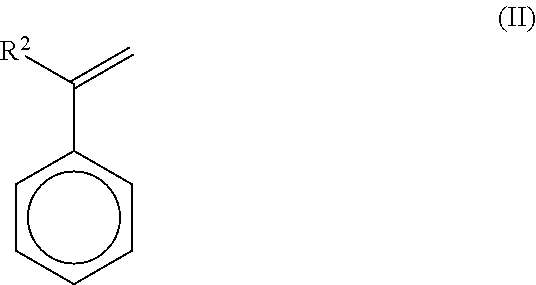Toner for electrophotography
a technology for electrophotography and toner, applied in the field of toner for electrophotography, can solve the problems of image defects, lowering gloss or durability, and high cost of toner,
- Summary
- Abstract
- Description
- Claims
- Application Information
AI Technical Summary
Benefits of technology
Problems solved by technology
Method used
Image
Examples
examples 1 to 9 and 11
(Step 1)
[0449]A 10-liter four-neck flask equipped with a nitrogen inlet tube, a dehydration tube, a stirrer, and a thermocouple was charged with a polyester in a given amount as listed in Table A-2. The temperature was raised to a temperature described in Table A-2 in a nitrogen atmosphere, to melt the polyester. Thereafter, a polylactic acid in a given amount as listed in Table A-2 was added thereto, and the mixture was stirred for a given time as listed in Table A-2 to carry out partial transesterification to provide a resin composition containing a polyester-polylactic acid copolymer. The resulting resin composition was cooled to 40° C. or lower, and the resin composition was then roughly pulverized with Rotoplex, manufactured by Hosokawa Micron Corporation, and a sieve having a sieve opening of 2 mm was used to provide a resin composition containing a polyester-polylactic acid copolymer having a particle size of 2 mm or less. The resin compositions prepared in each of Examples a...
example 10
[0456]Toner raw materials were mixed in Example 1 with a Henschel mixer, and the mixture was melt-kneaded under the conditions given below.
[0457]The melt-kneading was carried out with a co-rotating twin-screw extruder “PCM-30,” manufactured by IKEGAI Corporation, having a screw diameter of 2.9 cm and a cross-sectional area of the screw of 7.06 cm2. The operating conditions were such that the barrel setting temperature was 100° C., a rotational speed of the screw was 200 r / min, i.e. a peripheral speed of the screw rotations was 0.30 m / sec, and a mixture supplying rate was 10 kg / hr, i.e. a feeding rate of the mixture per unit cross-sectional area of the screw was 1.42 kg / hr·cm2, to provide a melt-kneaded mixture.
[0458]The resulting melt-kneaded mixture was subjected to rough pulverization and fine pulverization in the same manner as in Example 1, and the finely pulverized product was subjected to a classification treatment, to provide toner matrix particles.
[0459]The resulting toner m...
example 12
(Step 2B)
[0460]In 1-liter beaker, 30 g of resin composition RC-1 and 270 g of chloroform were mixed while stirring at 25° C. to dissolve the RC-1, 24 g of an anionic surfactant “NEOPELEX G-15,” manufactured by KAO Corporation., 15% by mass sodium dodecylbenzenesulfonate solution, and 147.5 g of deionized water were added thereto, and thereafter the mixture was stirred for 30 minutes, at a rotational speed of 8,000 r / min with “T.K. ROBOMIX,” manufactured by PRIMIX Corporation, to prepare the emulsion. Chloroform was distilled away from the resulting emulsion under a reduced pressure to provide an aqueous dispersion of resin composition RC-1 (Aqueous Dispersion E-1).
[0461](Preparation of Aqueous Dispersions of Polyester)
[0462]A 3-liter vessel equipped with a stirrer, a reflux condenser, a dropping funnel, a thermometer and a nitrogen inlet tube was charged with 150 g of polyester II-1 and 75 g of ethyl acetate, and the mixture was dissolved at 70° C. over 2 hours. A 20% by mass aqueou...
PUM
| Property | Measurement | Unit |
|---|---|---|
| temperature | aaaaa | aaaaa |
| temperature | aaaaa | aaaaa |
| time | aaaaa | aaaaa |
Abstract
Description
Claims
Application Information
 Login to View More
Login to View More - R&D Engineer
- R&D Manager
- IP Professional
- Industry Leading Data Capabilities
- Powerful AI technology
- Patent DNA Extraction
Browse by: Latest US Patents, China's latest patents, Technical Efficacy Thesaurus, Application Domain, Technology Topic, Popular Technical Reports.
© 2024 PatSnap. All rights reserved.Legal|Privacy policy|Modern Slavery Act Transparency Statement|Sitemap|About US| Contact US: help@patsnap.com










